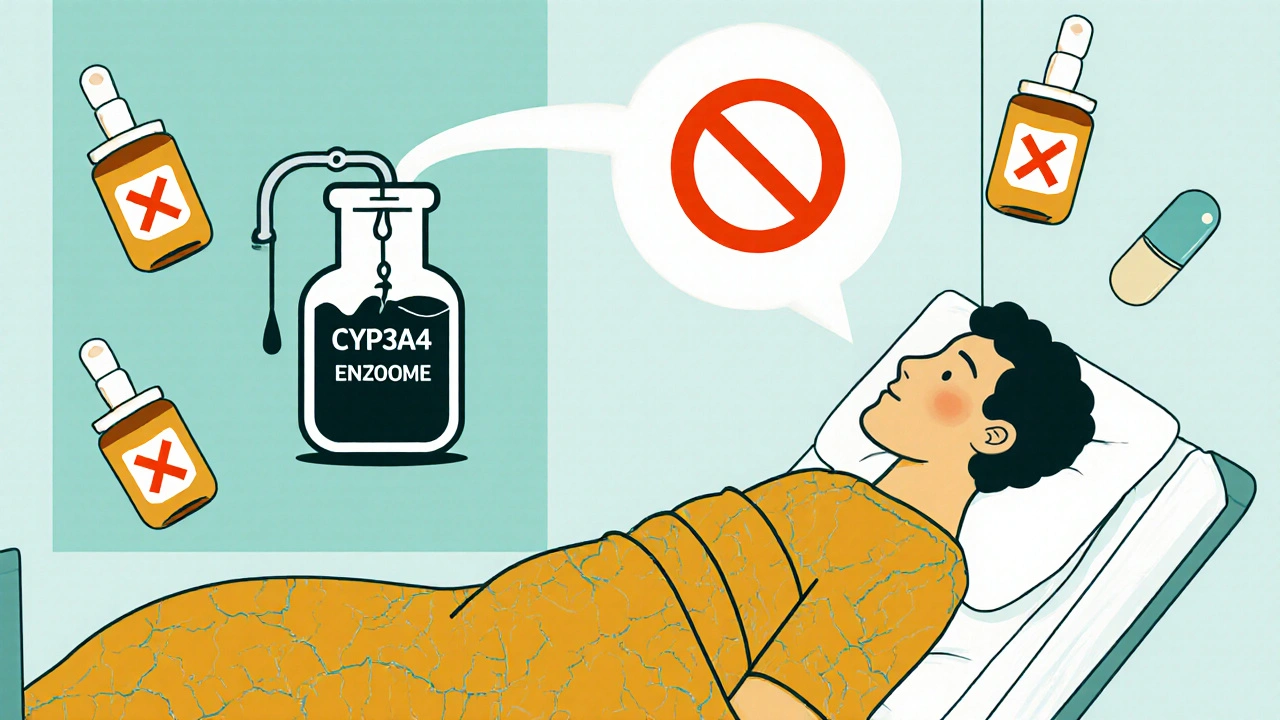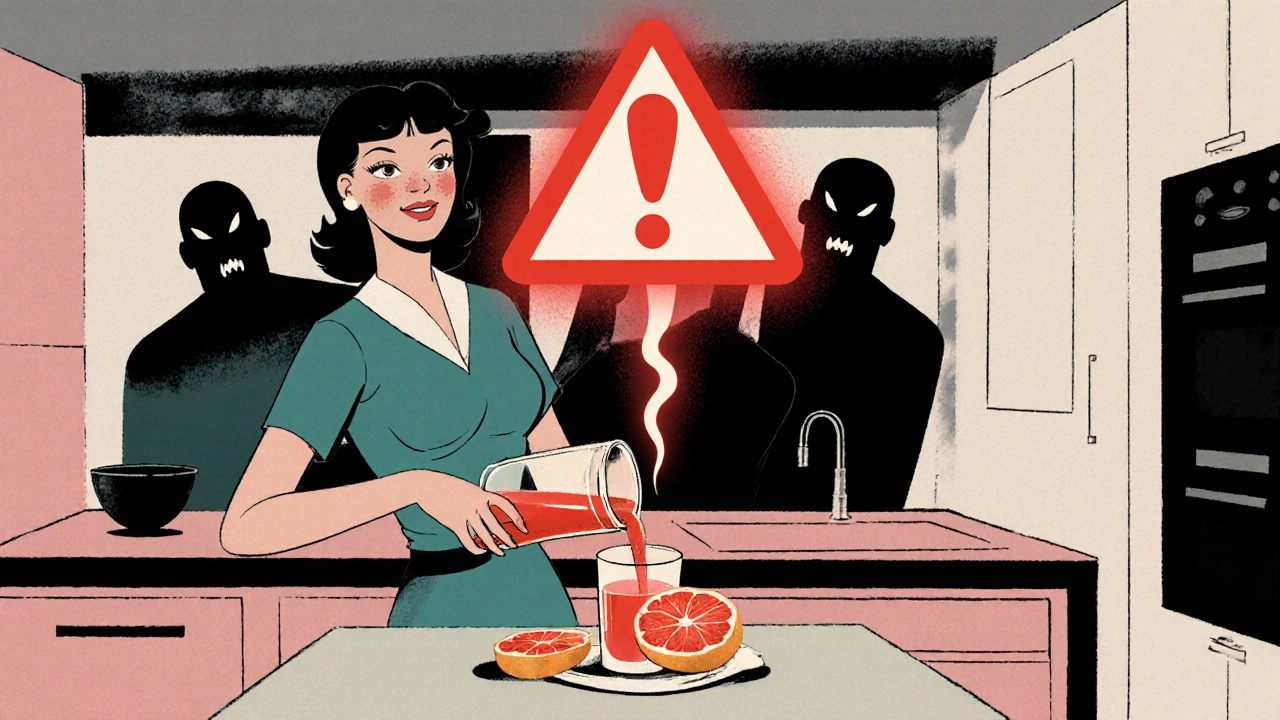Simvastatin Drug Interaction Checker
Check Your Medications
Enter any medication you're taking to see if it has dangerous interactions with simvastatin.
Simvastatin works. It lowers cholesterol. For millions of people, it’s kept heart attacks and strokes at bay. But here’s the part no one tells you until it’s too late: simvastatin can turn deadly if mixed with the wrong drugs-or even the wrong breakfast.
Back in 2011, the FDA pulled the plug on one specific dose: 80 mg. Not because it didn’t work. Because it was killing people. The risk of rhabdomyolysis-a condition where muscle tissue breaks down so fast it clogs your kidneys and can kill you-jumped from 0.08% at 20-40 mg to 0.61% at 80 mg. That’s more than seven times higher. And it wasn’t just the dose. It was what people were taking with it.
Why Simvastatin Is So Fragile
Simvastatin doesn’t just float through your body. It’s processed by one enzyme: CYP3A4. Think of it like a narrow hallway. If too many people try to walk through at once, everything backs up. That’s what happens when you take other drugs that block CYP3A4. Simvastatin piles up in your bloodstream. And when it does, your muscles start to break down.
This isn’t theoretical. In clinical settings, patients on simvastatin 40 mg were fine-until they got antibiotics like clarithromycin for a sinus infection. Within days, they couldn’t stand up. Their muscles ached like they’d run a marathon for a week. Their urine turned dark. By the time they got to the ER, their creatine kinase levels were through the roof. Rhabdomyolysis. ICU. Sometimes, death.
The Deadliest Combinations
Some drugs are outright banned with simvastatin. The FDA says: never combine simvastatin with these:
- Ketoconazole, itraconazole, voriconazole, posaconazole (antifungals)
- Erythromycin, clarithromycin, telithromycin (antibiotics)
- Cyclosporine (used after organ transplants)
- Danazol (a hormone drug)
- Nefazodone (an antidepressant)
- All HIV protease inhibitors: ritonavir, atazanavir, darunavir, indinavir, and others
- Cobicistat (a booster used with HIV meds)
These aren’t just "be careful" warnings. They’re red lights. If you’re on any of these, simvastatin is off the table. Period.
Even moderate interactions can be dangerous. Calcium channel blockers like diltiazem or verapamil? Max simvastatin dose drops to 10 mg. Amiodarone or amlodipine? Max 5 mg. Colchicine? Used for gout? It can stack with simvastatin and trigger muscle damage-even at normal doses.
Grapefruit Juice: The Silent Killer
You’ve heard it before. But do you really get it?
One glass of grapefruit juice-8 ounces-can spike simvastatin levels by 260%. That’s not a little bump. That’s the difference between a safe dose and a toxic one. And it doesn’t matter if you drink it in the morning, at night, or on the weekend. The enzyme inhibition lasts for hours. Even a single serving can be enough to push someone over the edge.
Studies show 43% of people on high-dose simvastatin still drink grapefruit juice. They think, "It’s just juice." But for them, it’s a ticking time bomb. Pharmacists in Vancouver and Calgary report patients showing up with muscle pain, not realizing their morning smoothie was the culprit.

The 80 mg Dose: A Prescription for Disaster
Before 2011, doctors prescribed 80 mg simvastatin like it was a miracle cure for stubborn cholesterol. Then came the data. The SEARCH trial. The FDA’s own adverse event reports. The numbers didn’t lie.
At 80 mg, the risk of rhabdomyolysis was 10 times higher than with other statins at similar doses. And the damage wasn’t just rare-it was catastrophic. Patients didn’t just get sore muscles. They had kidney failure. They needed dialysis. Some didn’t survive.
Today, new patients almost never start on 80 mg. That dose is now used in less than 2% of new prescriptions. The American College of Cardiology says: don’t start anyone on it. If you’re already on it? Your doctor should be reviewing whether you even need it. There are safer, stronger options now-rosuvastatin, pitavastatin, atorvastatin-that don’t get wrecked by CYP3A4 inhibitors.
What to Do If You’re on Simvastatin
If you’re taking simvastatin, here’s your action list:
- Check your dose. If it’s 80 mg, ask your doctor why. Is there a safer alternative?
- Review every medication. Including over-the-counter drugs, supplements, and herbal products. Even St. John’s Wort can interfere.
- Never drink grapefruit juice. Not once. Not occasionally. Not "just this one time."
- Know the warning signs. Unexplained muscle pain, weakness, or tenderness-especially if you’re also feeling tired or your urine is dark brown. Call your doctor immediately.
- Get liver tests. ALT and AST levels should be checked every 3-6 months. If they’re climbing, it’s a sign your liver is under stress.
- Ask about genetic testing. The SLCO1B1 gene variant makes some people 4.5 times more likely to develop muscle damage on simvastatin. If you’re on a high dose, this test could save your life.

What Your Pharmacist Can Do
Most people don’t realize pharmacists are the last line of defense. They see every prescription you fill. They run interaction checks. But they can’t help if you don’t tell them everything.
Bring your whole pill bottle to the pharmacy-not just the new script. Tell them about the supplements you take. The herbal teas. The OTC painkillers. If you’re on simvastatin and your pharmacist flags a conflict, listen. They’ve seen what happens when people ignore these warnings.
Studies show pharmacy-based intervention programs cut dangerous combinations by 67% in older adults. That’s not magic. That’s vigilance.
What’s Replacing Simvastatin?
Simvastatin isn’t disappearing. It’s just being pushed to the sidelines. For most people, especially those on other meds, doctors now choose statins that don’t rely on CYP3A4:
- Rosuvastatin (Crestor) - Works well, fewer interactions, longer half-life
- Pitavastatin (Livalo) - Minimal CYP3A4 involvement, great for complex med regimens
- Pravastatin (Pravachol) - Metabolized differently, safer with other drugs
These aren’t "new" drugs. They’ve been around for years. But now, they’re the first choice-not the backup.
And yes, simvastatin is cheap. Generic 20 mg costs about $4 a month. But when you factor in ER visits, hospital stays, dialysis, and lost work? The real cost is far higher.
Bottom Line
Simvastatin isn’t evil. It’s powerful. And like any powerful tool, it needs respect.
If you’re on it:
- Don’t take 80 mg unless you’ve been thoroughly evaluated and have no other option.
- Never mix it with the drugs listed above.
- Avoid grapefruit juice like it’s poison-because for you, it is.
- Know your symptoms. Act fast if something feels wrong.
- Ask your doctor: "Is there a safer statin for me?"
Cholesterol matters. But your muscles, your kidneys, your life? They matter more.
Can I take simvastatin with antibiotics?
Some antibiotics are deadly with simvastatin. Never take clarithromycin, erythromycin, or telithromycin with it. Even a short course can trigger rhabdomyolysis. Other antibiotics like amoxicillin or azithromycin are usually safe, but always check with your pharmacist before starting any new drug.
Is grapefruit juice really that dangerous with simvastatin?
Yes. One 8-ounce glass can increase simvastatin levels by up to 260%. This isn’t a myth-it’s proven in clinical studies. Even occasional consumption raises your risk of muscle damage. If you’re on simvastatin, avoid grapefruit juice entirely. Oranges, tangerines, and other citrus fruits are safe alternatives.
What should I do if I accidentally took simvastatin with a bad interaction?
Stop taking simvastatin immediately. Call your doctor or go to the ER if you have muscle pain, weakness, dark urine, or unexplained fatigue. Don’t wait. Rhabdomyolysis can escalate quickly. Bring your medication list with you. The sooner you get tested for creatine kinase and kidney function, the better your outcome.
Is simvastatin 80 mg still prescribed today?
Rarely. Since the FDA’s 2011 safety warning, new prescriptions for 80 mg simvastatin have dropped by over 80%. It’s now only considered for patients who failed all other statins and have severe, uncontrolled cholesterol-under strict monitoring. Most doctors won’t even write the script anymore.
Can I switch from simvastatin to another statin safely?
Yes, and it’s often recommended. Rosuvastatin, pitavastatin, and pravastatin have far fewer drug interactions. Switching usually involves stopping simvastatin for a few days, then starting the new statin at a low dose. Your doctor will monitor your cholesterol and liver enzymes to ensure the switch is safe and effective.
Do I need genetic testing before taking simvastatin?
It’s not required, but it’s smart-if you’re considering a high dose (40 mg or more). The SLCO1B1 gene variant increases your risk of muscle damage by up to 4.5 times. If you have this variant, your doctor may choose a different statin or keep your dose very low. Testing is available through most major labs and is often covered by insurance if you’re on high-dose therapy.
How often should I get blood tests on simvastatin?
Before starting, you should have a baseline liver enzyme test (ALT/AST) and CK level. After starting, get tested again at 6-12 weeks. If everything’s normal, continue testing every 3-6 months. More frequent testing is needed if you’re on a high dose, taking interacting drugs, or have muscle symptoms.


Write a comment